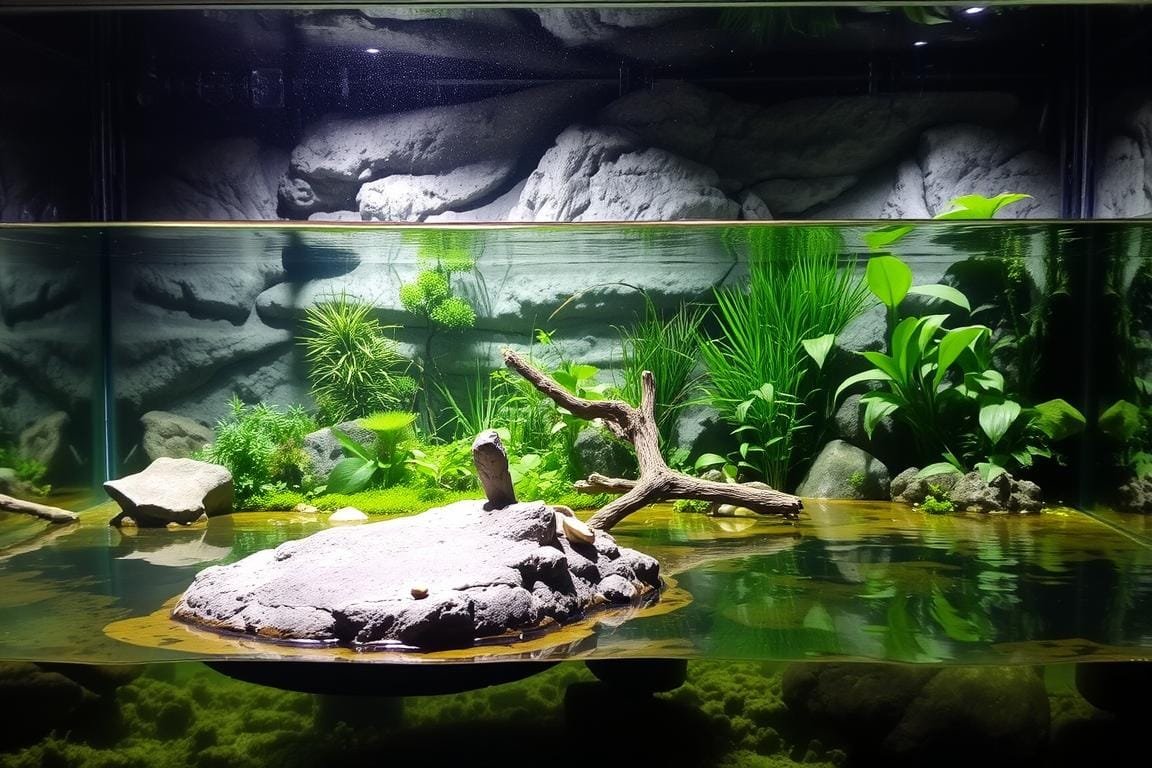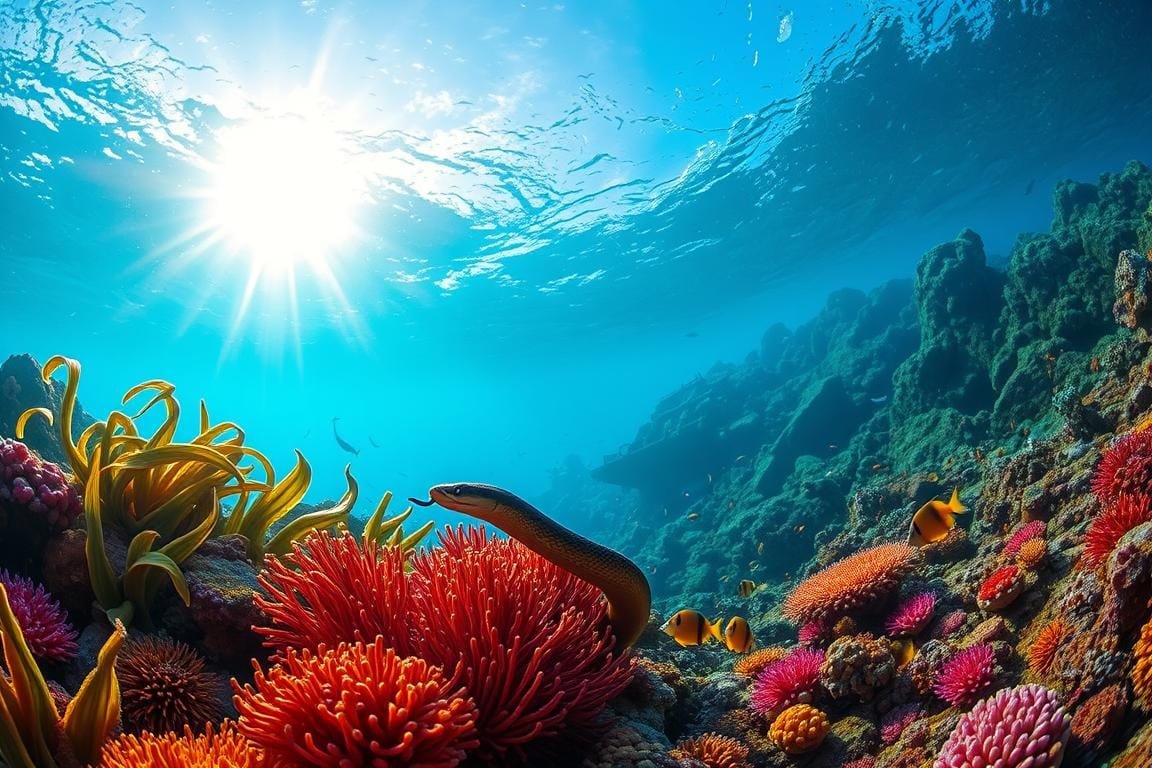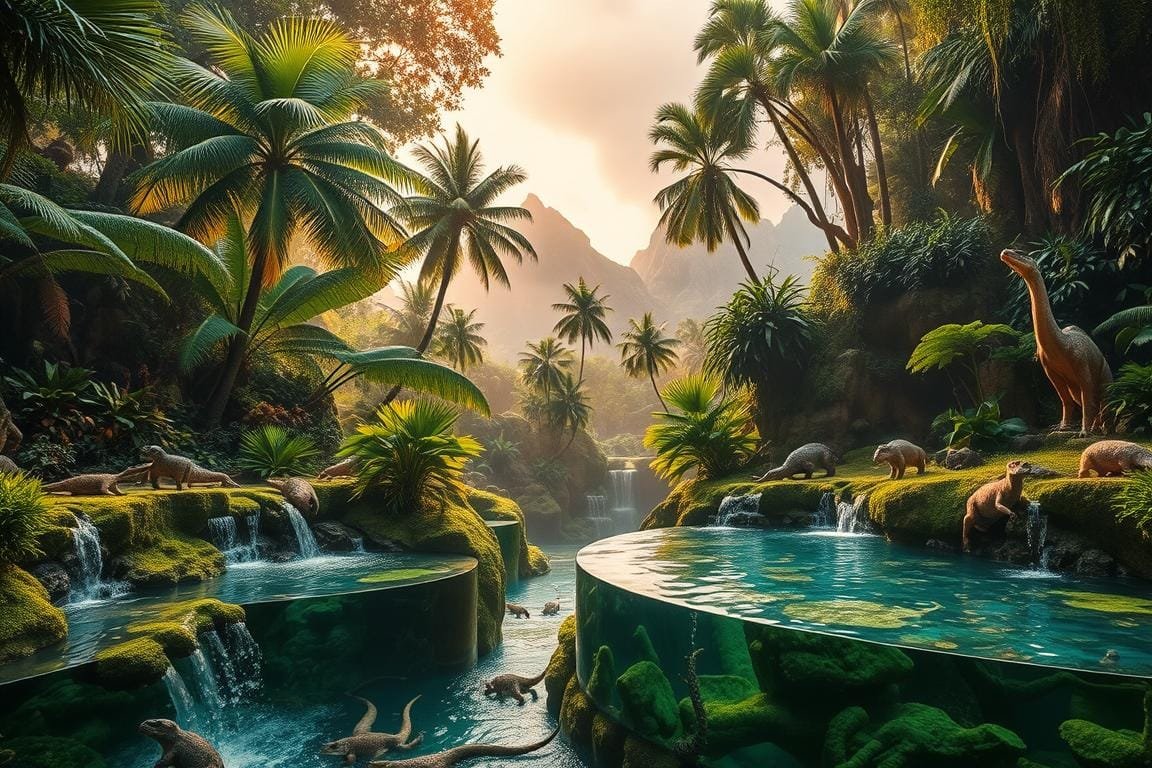Creating a thriving home for aquatic pets like the red-eared slider requires careful planning. These fascinating creatures grow up to 12 inches long and need spacious environments to stay healthy. A well-designed habitat isn’t just about looks—it’s about meeting their unique needs for years to come.
Popular species, such as sliders, demand large tanks with clean water and dedicated basking zones. Without UVB lighting, they risk developing weak bones and shells. That’s why proper turtle tank setup is crucial from day one.
Many people underestimate the size and lifespan of these pets. Some live over 20 years! Their diet and water quality must align with their natural habits to prevent health issues. With the right balance of space, light, and care, they become rewarding companions.
This guide will walk you through tank requirements, species-specific tips, and maintenance routines. Whether you’re new to aquatic pets or refining your skills, we’ll help you build a habitat where your shelled friend can flourish.
Understanding the Basics of Turtle Care
Owning these shelled reptiles is a long-term commitment that demands species-specific knowledge. Unlike fish, they need both aquatic and dry areas to mimic their natural behavior. Their diets vary widely—some prefer leafy greens, while others crave protein-rich snacks like insects.
Meet the Popular Species
Red-eared sliders (Trachemys scripta) thrive in spacious tanks with UVB lighting. Map turtles require stronger water currents, similar to river habitats. Painted turtles often bask more frequently, needing larger dry zones. Each species has unique needs:
| Species | Adult Size | Habitat Preference | Diet Focus |
|---|---|---|---|
| Red-Eared Slider | 10-12 inches | Warm, still water | 50% plants, 50% protein |
| Map Turtle | 4-10 inches | Moving water | 70% protein |
| Painted Turtle | 5-7 inches | Shallow basking areas | 60% plants |
Why Size and History Matter
In 1975, the U.S. banned sales of small reptiles under 4 inches to reduce Salmonella risks. This rule still affects pet stores today. Always choose healthy juveniles from reputable breeders.
Pro tip: Invest in a robust filtration system. These messy eaters produce more waste than fish, requiring frequent water changes. Pair this with regular calcium supplements to support shell health.
Essential Components of a Freshwater Turtle Aquarium
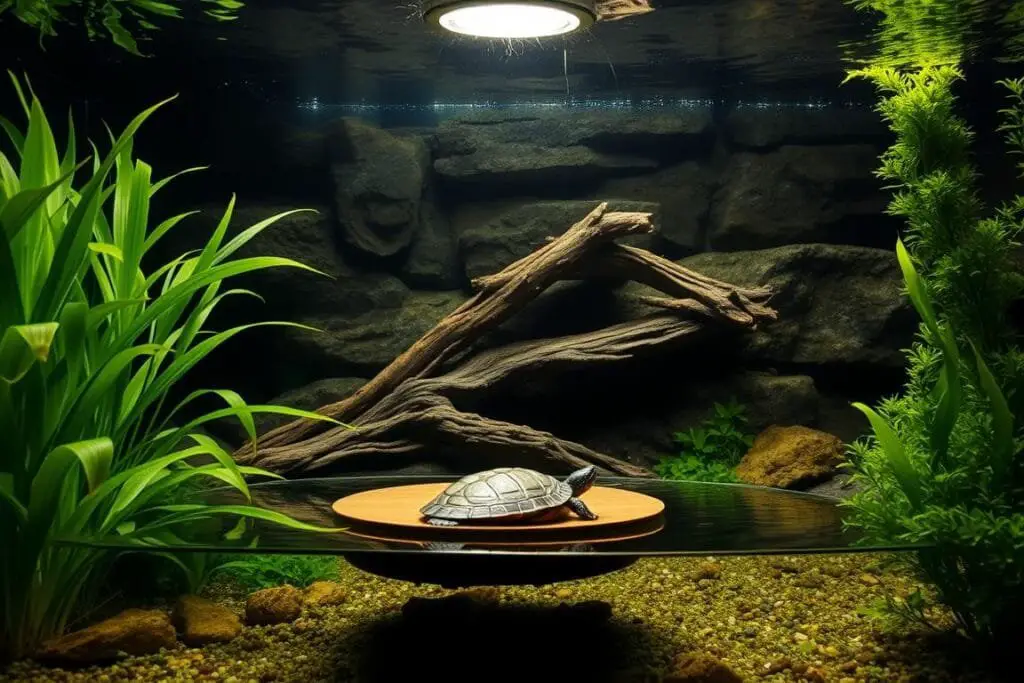
The foundation of a healthy environment for aquatic species lies in space and systems. Getting these elements right ensures your pet thrives while simplifying maintenance. Let’s break down what you’ll need to create a functional habitat.
Tank Size and Housing Options
Start with a container that matches your pet’s growth potential. Many species reach 10+ inches long, needing at least 10 gallons of water per inch of shell. Housing options vary:
- Glass aquariums: Clear visibility but heavy when filled
- Plastic stock tanks: Lightweight and affordable, ideal for larger setups
- Pond-style enclosures: Best for outdoor habitats in warm climates
Filtration, Lighting, and Heating Essentials
Clean water and proper temperatures prevent common health issues. Follow this checklist:
- Choose a filtration system rated for 2-3x your tank’s volume
- Install UVB bulbs above basking zones to support shell development
- Use submersible heaters to maintain 75-85°F water temperatures
For softshell species, skip rough substrates to protect delicate skin. Pair equipment with weekly partial water changes—this combo keeps habitats fresh for years. Planning ahead saves time and stress as your pet grows!
Designing a Healthy Habitat for Aquatic Turtles
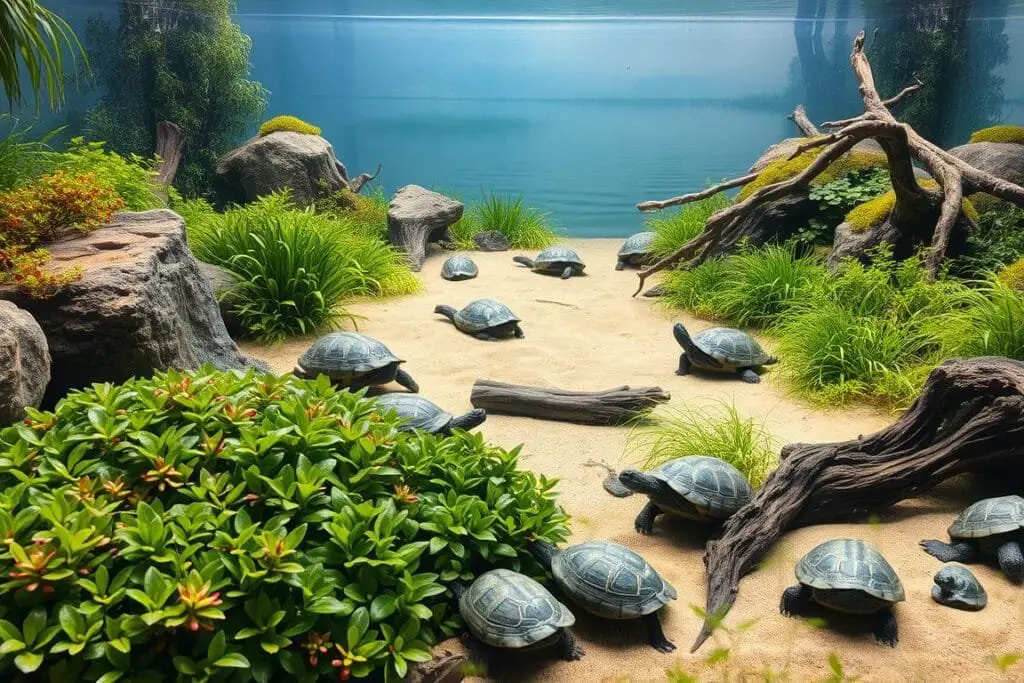
Building a comfortable home for shelled pets starts with replicating nature’s blueprint. Thoughtful design choices promote natural behavior while keeping your aquatic friend safe. Let’s explore how to balance aesthetics and functionality.
Optimizing Substrate, Décor, and Basking Spots
Start with a substrate that suits your pet’s needs. Smooth river rocks or coarse sand work well for most species. Avoid small gravel—curious eaters might swallow it! Add driftwood or PVC pipes for hiding spots. These mimic wild environments and reduce stress.
Basking areas need two features: stability and warmth. Use flat slate rocks or floating platforms. Secure them firmly to prevent tipping. For map turtles, include elevated perches near water currents. Painted turtles prefer wide, sunlit surfaces. Learn more about ideal setups from this guide on aquatic turtle habitats.
Establishing Temperature Zones
Create three distinct areas in the tank:
- Basking zone: 85–90°F with UVB lighting
- Warm water: 75–80°F for swimming
- Cool zone: 70–75°F for resting
| Species | Basking Needs | Water Depth |
|---|---|---|
| Map Turtles | Rocky ledges | 12–18 inches |
| Painted Turtles | Flat platforms | 6–10 inches |
| Softshell | Sandy slopes | 10–14 inches |
Leave ample swimming space by arranging décor along the tank’s edges. Check daily that heaters and lights function properly—your pet’s shell health depends on it!
Planning the Perfect Diet and Turtle Feeding Strategies
Feeding your shelled companion isn’t just about filling a bowl—it’s about crafting menus that evolve with their needs. Young aquatic turtles often require more protein, while adults thrive on leafy greens. A mix of commercial pellets, live snacks, and veggies keeps meals exciting and nutritious.
Creating a Balanced Diet with Variety
Start with high-quality pellets as a base, but don’t stop there. Rotate these three food groups weekly:
- Protein sources: Earthworms, shrimp, or crickets (ideal for young Trachemys scripta)
- Greens: Kale, dandelion leaves, or aquatic plants
- Supplements: Calcium powder dusted on food twice weekly
Red-eared sliders shift from 70% protein to 50% plants as they grow. For smaller species like musk turtles, keep protein at 60-70% even in adulthood. Match portion sizes to shell length—feed an amount equal to the size of their head every 2-3 days.
Feeding Techniques for Optimal Health
Use a separate container for meals. This reduces tank mess and lets you track how much they eat. Most turtles finish eating in 15 minutes—remove leftovers to keep water clean.
Adjust feeding frequency based on age:
- Juveniles: Daily meals
- Adults (4+ years): Every other day
Always offer food in water—they can’t swallow properly on land. With smart strategies, your pet gets the nutrients they need without overfeeding. Happy turtles mean healthier companions for years to come!
Maintaining Water Quality and Routine Aquarium Care
Clear water isn’t just about looks—it’s a lifeline for your pet’s well-being. Consistent care prevents harmful bacteria and keeps shells strong. Let’s explore simple ways to create a stable environment that supports active, healthy lives.
Weekly Cleaning Made Simple
Replace 25-50% of the water every 7 days. Use a gravel vacuum to remove waste trapped in substrate. Always treat new water with dechlorinator—chemicals harm sensitive skin.
For tanks over 40 gallons, split changes into two sessions. This reduces stress on pets. Mark your calendar or set phone reminders to stay consistent.
Filter Care for Crystal-Clear Water
Canister filters need monthly rinsing with tank water (never tap!). Hang-on-back models require weekly media checks. Follow this schedule:
| Filter Type | Maintenance Frequency | Key Task |
|---|---|---|
| Canister | Every 4 weeks | Clean impeller, replace carbon |
| Sponge | Biweekly | Squeeze debris in bucket |
| Internal | Weekly | Check intake screens |
Test water weekly with strips. Aim for 0 ammonia, under 40 ppm nitrates. Pair this with timed lighting—10-12 hours daily prevents algae blooms.
Pro tip: Keep a maintenance journal. Track changes, filter cleanings, and behavior notes. Spot problems early and adjust routines as pets grow!
Final Thoughts on Your Turtle Aquarium Setup
Your shelled companion’s health depends on balancing their ecosystem with precision. From spacious tanks to UVB lighting, every detail shapes their lifespan and vitality. Remember: species like musk turtles need shallower waters, while sliders demand room to grow.
Successful habitats blend three essentials: clean water through robust filtration, temperature-controlled zones, and diets tailored to age. Weekly maintenance prevents issues before they start—test strips and partial changes keep environments stable. For visual guides, explore this step-by-step turtle tank setup resource.
These reptiles thrive when their care mirrors wild behaviors. Include basking platforms and hiding spots to reduce stress. Many turtle species live decades, making research and planning non-negotiable.
Approach your setup with patience. Track progress, adjust routines, and celebrate small wins. With dedication, you’ll create a dynamic home where curiosity and natural instincts shine!

